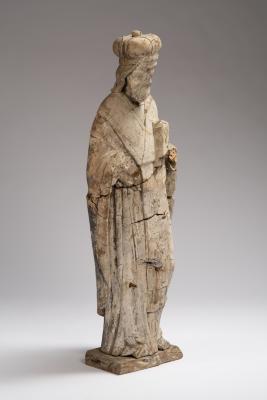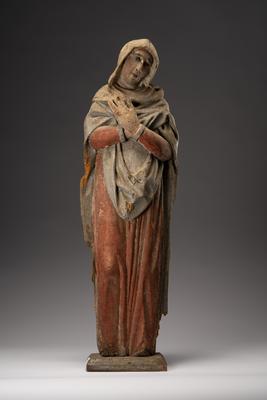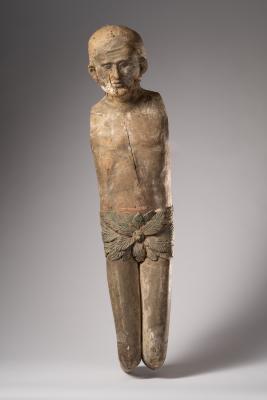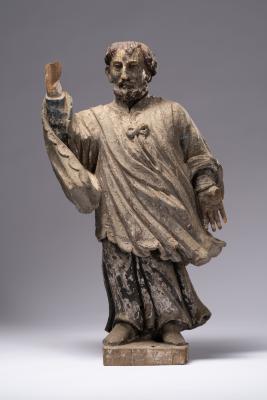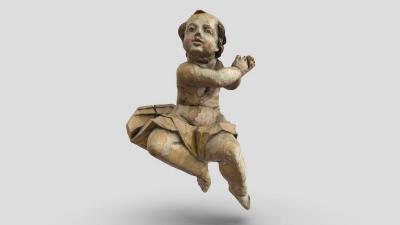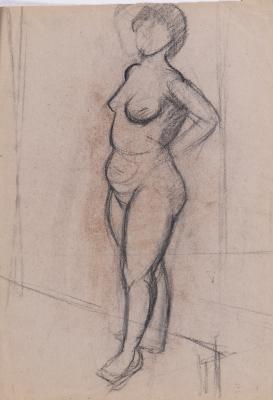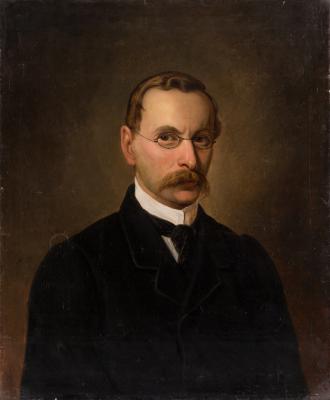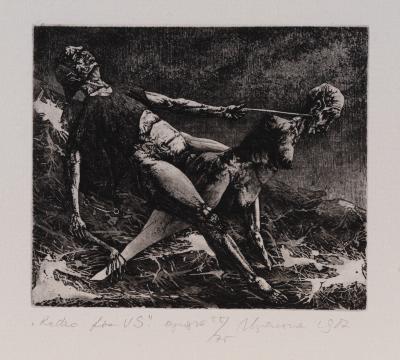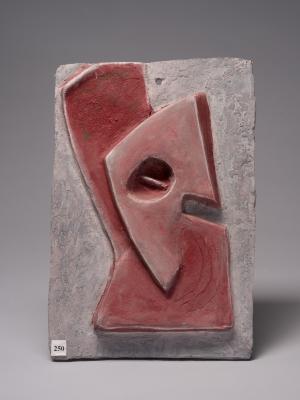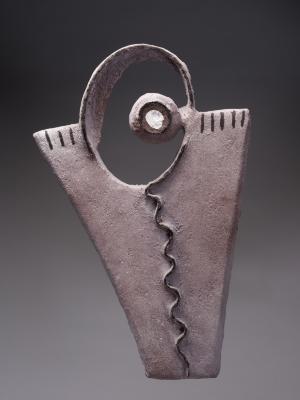Sheet 9 from the Graphic Cycle "Jonathan Swift's Kingdom of Absurdity"
Alexander Aksinin
- ID
- Г-IV-3646
- Author
- Alexander Aksinin
- Name
- Sheet 9 from the Graphic Cycle "Jonathan Swift's Kingdom of Absurdity"
- Date of creation
- 1978
- Technique
- etching
- Material
- imprint on paper
- Dimensions (height x width, cm)
- 29.1 x 29.6
- Type
- printmaking
- Provenance
- Purchased and kept in permanent storage,1983
The work is the ninth sheet of 11 etchings from the graphic cycle "Jonathan Swift's Kingdom of Absurdity". In this work, we trace Alexander Aksinin's visual interpretation of the metaphysical system of the Anglo-American mathematician and philosopher Alfred North Whitehead (1861–1947). Aleхandеr Aksinin's sketch "End Face" (1978) with the subtitle "Whitehead" is a result of a thorough study of the review of Alfred North Whitehead's conceptual work "Process and Reality" (1929). In the ninth sheet, this sketch becomes a fragment of a complex composition.
The composition is presented in a circle. The ornithomorphic vertical image, which resembles an eagle owl with feathers on its head, claws, and a tail below, dominates the work. The bird's eyes are replaced by hand braces, which actuate the cable with the pupil in a circle. The planes of the level discs are filled with craters resembling trumpets, bells with bell ringers, spools of twine with fish heads in the holes, and drums with figures of drummers. A cut fish (image in the basic sketch "End Face"), shells on the edge of the disk, and a whirligig on a drum are shown as separate elements. Two figures unwinding the rug are situated on the axis of the last plane above the eagle owl's tail, which is made of poles. Above them is a circle with a pupil in the middle, from which the rays radiate. This eye and the bottom part of the torso are similar to a clock pendulum. Analogous pupil circles above the bird's head and beside its legs are essential compositional elements. The upper segment symbolises the sky. It consists of a circle with the pupil, which radiates the segments with balls resembling Japanese umbrellas at the bottom. Japanese motifs can also be traced on the top of the bird's head, which looks like a pagoda, and in the poles on the right side of the segment, which are folded like fans. The circles with pupils are associated with the chrysanthemum emblem of the Emperor of Japan.
Lemuel Gulliver's last trip, briefly described in Chapter III, was to Japan, the only real country among the imaginary ones in "Gulliver's Travels". However, this land is also presented in the book as semi-real.
The sea voyage in Alexander Aksinin's composition is proved by fragments of the middle and lower parts of the work. They symbolise the sea space formed by drops from pipes and the faucet on brick walls outlined horizontally by wide light ribbons. In addition to ships, one can notice fishermen, boats, and rafts with Ionic columns on the water surface. On the capitals of the columns, there are owls. Flying down balls are situated to the left of the upper "celestial" segment. They gradually increase in shape and turn into containers with needles. A large fish is trying to swallow one of these balls. The balls under the owl's "head" on the left in the depths form another disc with craters, on the edge of which sits a fisherman. A fragment of a similar disc is shown on the right. Above it, a man sits and grinds droplets-pebbles falling from above the tubes of the "fan" in a spherical mechanism with a crater. The mechanism resembles fantastic devices from the academy in "Laputa".
The author's signature is etched on the middle ribbon on the right: A. Aksinin–78.
In this work, the author collects and synthesises various aspects of Gulliver's travels, combining them into a single ornithomorphic structure. As in the other last sheets of the series, the artist moves away from direct connections with Jonathan Swift's texts and offers a visual interpretation of universal problems.









